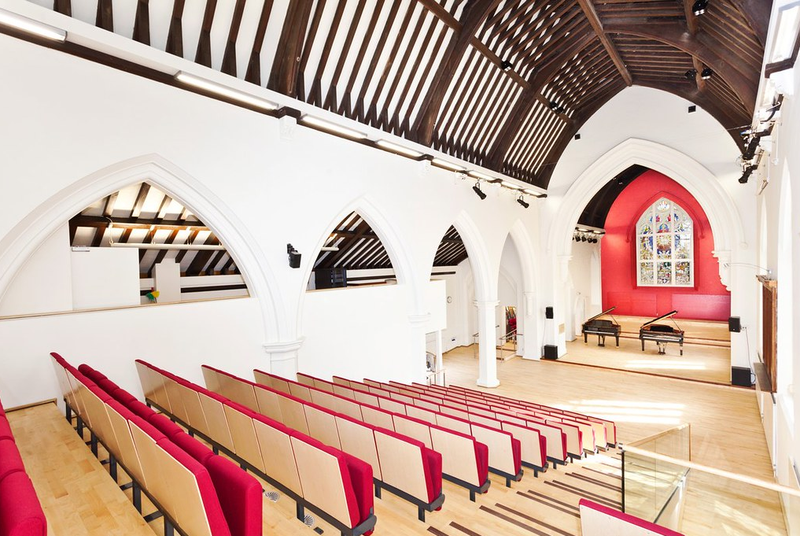[....] Cardiff Opera House
Now back to the St Gregory Music Centre
It was the intention to write a piece of music taking an intersection of Emma-Kate Matthews’ music, with that of Megan Steinberg and Milton Mermikides, with own ideas from before on interpreting architecture abstractly, combining in some variant, in other words a data driven piece that could subsist as a direct or vicarious comment upon some specific architectural detail of ZH, including her speciality of abstraction.
However, when perusing the ZHA website the feelings overwhelmed and the miniaturised score was abandoned for adhering to the stance taken throughout, a holistic approach to ZH. Here the outright disgust or spleen was taken out on a short piece returning to SunVox as the medium, where the message was everything to say: I don’t like repeated loops (unless worked in a meaningful way such as in Space Machine), so let’s have them. An irreverent approach close to that of the Sex Pistols, around when ZH started in London and from whom she may have drawn some inspiration; it is thought that she did admire ‘punk’, perhaps as a rebellious expressive example taken against established architectural design. I don’t like cheap synthesizer sounds, so let’s have them. When playing with the keyboard of the new SunVox version strange sounds emerged from keys. These were played as weird electronic pads, creating a dissident polyrhythmic non rhythmic pattern going against the grain of the repeating loops. A graininess of disc scratching was welcomed as dissidence and a penchant for such sounds under an alternative heading of new materialism, a continuity factor, as used in Zaha Hadid the Life, possibly overly much then, left as a feeling of dissatisfaction with ZH’s early demise and solidarity with her force of character. This ended after 3:19 (m:s), shown as ‘prelude’. It is a way into this composition in a literally graphic way.
Thereafter, it was decided to return to the FRO and ask them to interpret a graphic score based upon ZH’s footprint of the opera house basic layout, with text suitable for ZH and as used by her, reference to Luke Jones and George Gingell two architect lecturers (2020, Ep. 3) who in a series of four videos provide accompanying analysis for any player to peruse, as well as added ontological subtle touches and personal colouration to transform ZH’s basic design into a score type known that the FRO could interpret. Having vented the spleen, it was envisaged that the FRO version could be gentle, melodic and textural, with emphasis upon the known inventive electronic section and opportunity given to the percussion section which often misses out on prominence.
However, in describing the score, as has evolved to be the practice, the incensing facts about ZH’s winning and losing the contract three times, possibly became conveyed at least to one member, maybe more, perhaps latching onto a feminist sisterhood angle, or plain empathy with the poor treatment she often received and definitely over this project, with the result that the now subsided anger of the author-composer becoming largely overlooked, in the subsequent playing. With an approach of always letting performers have their own voice, not editing where possible, the raw result combines elements of all these aspects, ‘punk’ type disgust, reverence for ZH’s ability and at times some melodic content to ‘soothe the savage breast’ (Schwartz, 2023. In order to draw out differentiation of texture, cue cards were given to each member in three section to separate the electronic and percussion sections, strings and wind, to start in that order and to replicate ZH’s often used stratagem of designing in layers.
It was agreed beforehand that we would end with a short free jam with all layers and sections playing together, although at the last minute a composer-conductor decision was made to start with percussion, leading into the electronic section, then bring in the rest. This is seen as a related yet separate piece in its own right. By this time the spleen in the orchestra seems to have been worked out. The author-composer took a cue from other students having their work recorded at the same time and conducted this last part suddenly cutting out, in retrospect, as ZH did. A player commented that this last free jam (still as based on ZH’s score) sounded like Miles Davis. With Jorge Bernal’s commentary upon Teo Marcero and Miles Davis’s Bitches Brew in connection with his architectural designs, this seemed particularly pleasing, free jazz with cuts and splices as Bernal (2003) likened to architectural deconstructivism, a hallmark of ZH.
Please note: some references and arguments are within the main thesis. Please refer to this and if anyone not having a copy would like one please contact via the end contact details. Thank you
